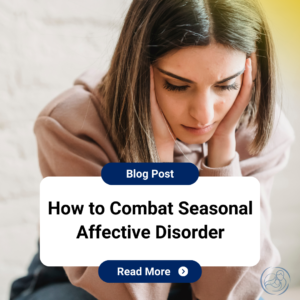How to Combat Seasonal Affective Disorder

Seasonal Affective Disorder (SAD) is a serious type of depression that occurs at a specific time of the year, usually during the fall and winter months when there is less sunlight. After spending the spring and summer outdoors, having to be inside continuously through fall and winter can be a big shift for some individuals.
Symptoms of SAD are similar to those of major depressive disorder and may include: Persistent feelings of sadness, hopelessness, or irritability; decreased interest in activities that were once enjoyable; feeling constantly tired or having low energy levels; disturbances in sleep patterns, such as oversleeping (hypersomnia) or difficulty sleeping (insomnia); changes in appetite, often leading to weight gain or loss; trouble focusing on tasks, making decisions, or remembering things; withdrawing from social activities and a desire to be alone; increased irritability or restlessness; negative thoughts about oneself, feeling guilty or worthless; aches and pains, such as headaches and body aches; slowed thinking and difficulty with concentration and memory; feeling more sensitive to perceived rejection or criticism; and difficulties in social relationships and a decline in performance at work or in other daily activities.
It’s important to note that the symptoms of SAD may vary in severity, and not everyone with SAD will experience all of these symptoms. Additionally, the symptoms of SAD are cyclical and tend to recur at the same time each year, usually in the fall and winter.
While it’s essential to consult with one of our healthcare professionals for personalized advice, here are some general strategies that may help combat Seasonal Affective Disorder:
- Exposure to bright light, particularly in the morning, can help regulate the body’s internal clock and improve mood. Light therapy involves sitting near a light box that emits a bright light, simulating natural sunlight.
- Increase your exposure to natural light by spending time outdoors, especially during daylight hours. Take short walks, go for a run, snow shoe, ski, shovel, or simply sit outside to get as much sunlight as possible.
- Engage in regular physical activity, as exercise has been shown to improve mood and reduce symptoms of depression. Aim for at least 30 minutes of moderate exercise most days of the week.
- Eat a well-balanced diet with a focus on whole foods, including fruits, vegetables, lean proteins, and whole grains. Omega-3 fatty acids found in fish may also have mood-enhancing effects.
- Stay socially connected with friends and family. Join clubs or group activities to maintain a support system and combat feelings of isolation.
- Limit time on social media or your computer. Too much time on social media can contribute to feelings of isolation and depression.
- Practice mindfulness meditation, deep breathing exercises, or progressive muscle relaxation to reduce stress and improve your overall sense of well-being.
- Ensure you get enough quality sleep by maintaining a consistent sleep schedule. Create a relaxing bedtime routine and make your sleep environment comfortable and conducive to rest.
- Some people with SAD may have lower levels of vitamin D. Consult with a healthcare professional to determine if vitamin D supplements are appropriate for you.
- Cognitive-behavioral therapy (CBT) and other forms of counseling can be effective in treating SAD. A mental health professional can help you develop coping strategies and address negative thought patterns. St. Gianna Clinic has a psychiatrist who can meet with you or a loved one and provide cognitive-behavioral therapy.
- Replace standard light bulbs with full-spectrum light bulbs in your home or workspace. These bulbs mimic natural sunlight and can contribute to improved mood.
- Schedule activities that you enjoy or used to enjoy that bring you a sense of fulfillment. Having positive experiences can counteract the symptoms of SAD.
It’s important to note that these suggestions may not work for everyone, and individual responses to treatment can vary.
If you suspect you or someone you know may be experiencing Seasonal Affective Disorder, it’s essential to seek help from a healthcare professional. They can provide a proper diagnosis, offer appropriate treatment options, and develop a plan to manage symptoms effectively. Treatment may include light therapy (phototherapy), psychotherapy, medications, lifestyle changes, or a combination of these approaches.
Contact the St. Gianna Clinic at 920-605-3115 to schedule an appointment with a health care provider. We are always here for you and often can accommodate same day appointments.
